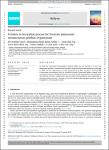A failure in decryption process for bivariate polynomial reconstruction problem cryptosystem
| dc.contributor.author | Yusof, SN | |
| dc.contributor.author | Kamel Ariffin, MR | |
| dc.contributor.author | Yip, S-C | |
| dc.contributor.author | Lau, TSC | |
| dc.contributor.author | Mahad, Z | |
| dc.contributor.author | Chin, J-J | |
| dc.contributor.author | Ting, C-Y | |
| dc.date.accessioned | 2024-02-14T07:52:04Z | |
| dc.date.available | 2024-02-14T07:52:04Z | |
| dc.date.issued | 2024-02 | |
| dc.identifier.issn | 2405-8440 | |
| dc.identifier.issn | 2405-8440 | |
| dc.identifier.other | e25470 | |
| dc.identifier.uri | https://pearl.plymouth.ac.uk/handle/10026.1/22051 | |
| dc.description.abstract |
In 1999, the Polynomial Reconstruction Problem (PRP) was put forward as a new hard mathematics problem. A univariate PRP scheme by Augot and Finiasz was introduced at Eurocrypt in 2003, and this cryptosystem was fully cryptanalyzed in 2004. In 2013, a bivariate PRP cryptosystem was developed, which is a modified version of Augot and Finiasz's original work. This study describes a decryption failure that can occur in both cryptosystems. We demonstrate that when the error has a weight greater than the number of monomials in a secret polynomial, p, decryption failure can occur. The result of this study also determines the upper bound that should be applied to avoid decryption failure. | |
| dc.format.extent | e25470-e25470 | |
| dc.format.medium | Electronic-eCollection | |
| dc.language | en | |
| dc.publisher | Elsevier BV | |
| dc.subject | Bivariate polynomial | |
| dc.subject | Decryption failure | |
| dc.subject | Polynomial reconstruction problem | |
| dc.subject | Post-quantum cryptography | |
| dc.subject | Univariate polynomial | |
| dc.title | A failure in decryption process for bivariate polynomial reconstruction problem cryptosystem | |
| dc.type | journal-article | |
| dc.type | Journal Article | |
| plymouth.author-url | https://www.ncbi.nlm.nih.gov/pubmed/38370193 | |
| plymouth.issue | 4 | |
| plymouth.volume | 10 | |
| plymouth.publisher-url | http://dx.doi.org/10.1016/j.heliyon.2024.e25470 | |
| plymouth.publication-status | Published | |
| plymouth.journal | Heliyon | |
| dc.identifier.doi | 10.1016/j.heliyon.2024.e25470 | |
| plymouth.organisational-group | |Plymouth | |
| plymouth.organisational-group | |Plymouth|Faculty of Science and Engineering | |
| plymouth.organisational-group | |Plymouth|Faculty of Science and Engineering|School of Engineering, Computing and Mathematics | |
| plymouth.organisational-group | |Plymouth|REF 2021 Researchers by UoA | |
| plymouth.organisational-group | |Plymouth|Users by role | |
| plymouth.organisational-group | |Plymouth|Users by role|Academics | |
| plymouth.organisational-group | |Plymouth|REF 2021 Researchers by UoA|UoA11 Computer Science and Informatics | |
| plymouth.organisational-group | |Plymouth|REF 2028 Researchers by UoA | |
| plymouth.organisational-group | |Plymouth|REF 2028 Researchers by UoA|UoA11 Computer Science and Informatics | |
| dc.publisher.place | England | |
| dcterms.dateAccepted | 2024-01-27 | |
| dc.date.updated | 2024-02-14T07:52:03Z | |
| dc.rights.embargodate | 2024-2-15 | |
| dc.identifier.eissn | 2405-8440 | |
| rioxxterms.versionofrecord | 10.1016/j.heliyon.2024.e25470 |


